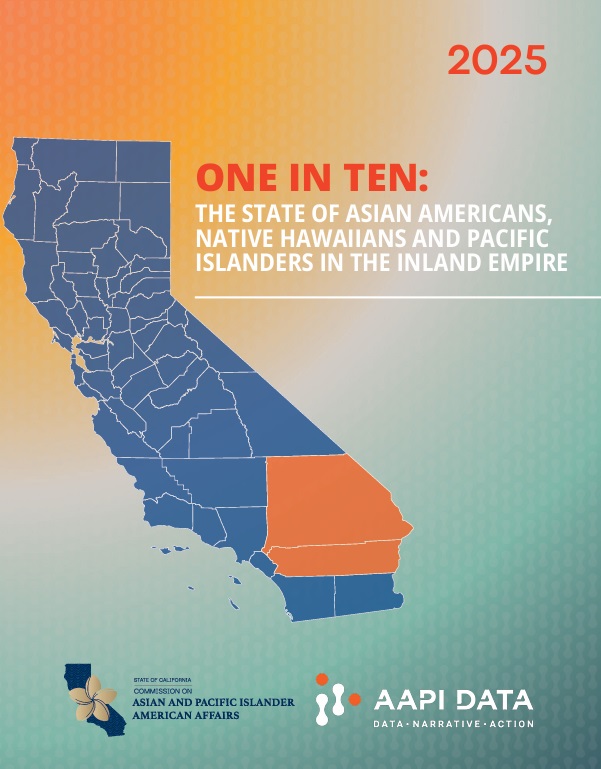THE STATE OF ASIAN AMERICANS, NATIVE HAWAIIANS AND PACIFIC ISLANDERS IN THE INLAND EMPIRE

Executive Summary
The Inland Empire region, encompassing Riverside and San Bernardino counties in southern California, spans over 27,000 square miles and is home to more than 4.5 million residents. The Inland Empire (or “the IE” as it is often called by community members) is one of the fastest- growing regions in California, and Asian Americans, Native Hawaiians, and Pacific Islander (AANHPI or AAPI) communities are an
important part of that growth story. The growth has been so dramatic and consequential that now one in every ten residents in the Inland Empire is Asian American and Pacific Islander. AAPIs are an integral part of the region’s economy, contributing to industries such as healthcare, logistics, and small business ownership. Many have moved to the region in search of affordable housing, high-quality education, and economic
opportunities, part of a broader trend of outward migration from urban centers. Despite this rapid growth, AAPIs remain underrepresented in critical discussions about economic opportunities, political leadership, and access to equitable resources. Insufficient research and visibility
further marginalize these communities, diminishing the ability of government agencies and relevant nonprofit organizations to fully understand and address their particular needs and concerns. Historically, the Inland Empire has faced significant disparities in funding and regional development compared to neighboring Los Angeles and Orange counties. These gaps are particularly evident for AAPI communities, where small community-based organizations play a crucial role in providing essential services but often lack the capacity and resources to secure funding and gain recognition from major funders. Without adequate support, these organizations struggle to meet the needs of their
growing communities. This report aims to highlight the urgency of investing in AAPI communities in the Inland Empire, and to amplify their voices in regional planning and policymaking.
Key findings from analyses of demographic data and interviews with community leaders, state leaders,
and funders revealed that:
• AAPIs are deeply embedded in the Inland Empire’s local economy. AAPIs play a vital role in the region’s economy, particularly in healthcare, logistics, and small businesses. Despite their strong presence in these industries, economic mobility within these sectors remains limited.
• Investments in AAPI civic engagement and political representation need to be strengthened. AAPI-serving organizations are essential for civic engagement but are often disconnected from major collaboratives that mobilize and engage workers and residents. Correspondingly, the
key opportunity to develop a comprehensive plan to expand AAPI political representation and leadership pipelines in the region also constitutes a means to elevate AAPI communities. In both efforts, faith-based organizations can play an important role.
• There are growing long-term health concerns and mental health needs for AAPIs in the region. Work-related injuries and long-term health effects are important concerns related to warehousing occupations. Mental health also is a significant source of apprehension for many
residents regardless of their age and occupation, but the region lacks culturally and linguistically aligned services to meet these needs.
KEY RECOMMENDATIONS
Consistent support for AAPI-serving organizations in the region would enable stakeholders to ensure stability in the resources that AAPI communities need to thrive and contribute to the region’s broader economic and social landscape. Key recommendations to respond to
the impediments that AAPI-serving organizations encounter in the Inland Empire include:
1) Creating an AAPI-focused community fund in the region, following the model of other community funds in the region, including the Black Equity Fund, the Inland Empire Community Foundation CIELO Fund, and the Inland Empire Journalism Innovation Hub+Fund.
2) Increasing funding and mentorship for nonprofit capacity building, including greater investments in collaborative capacity builders like the Inland Empire Community Collaborative.
3) Promoting more public-private partnerships, building on the efforts that Riverside County has made with respect to community health partnerships; and
4) Strengthening connections between AANHPI-serving organizations and existing collaboratives, such as Inland Empire United (for civic engagement), Growing Inland Achievement (for education), the Inland Empire Children’s Cabinet (for early childhood and youth concerns), the Inland Empire Journalism Hub (for narrative impact), strong labor organizations like Warehouse Workers Resource Center and Inland Empire Labor Council, and organizations with growing community-focused research capacity, such as the Inland Empire Labor and Community Center at the University of California, Riverside, and the Inland Empire Community Collaborative.
AAPI-serving organizations in the Inland Empire are subject to persistent resource gaps, perpetuating a cycle of “low capacity.” AAPI-serving organizations in the Inland Empire face ongoing challenges related to adequate and sustainable funding. Many operate with small teams, yet they continue to make outstanding contributions to their communities. These “tiny but mighty” groups already are driving meaningful change, but their impact is constrained by a lack of resources needed to sustain and scale their work.